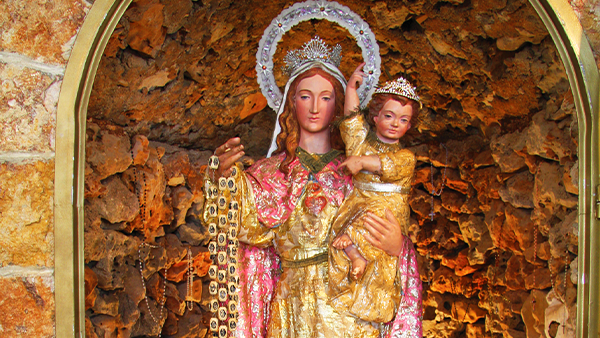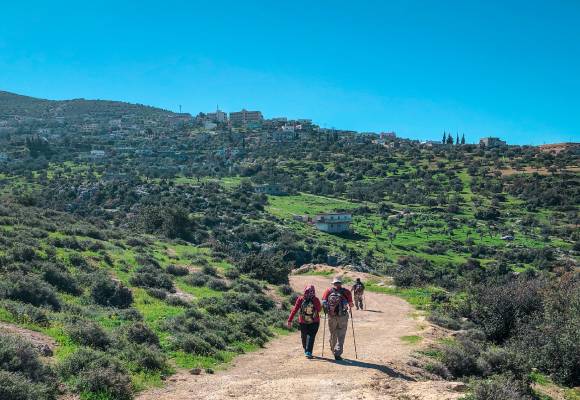Ajloun
Al Thuraya Travel & Tours
ATTRACTIONS
The marvels of nature and the genius of medieval Arab military architecture have given northern Jordan two of the most important ecological and historical attractions in the Middle East: the sprawling pine forests of the Ajloun-Dibbine area, and the towering Ayyubid castle at Ajloun, which helped to defeat the Crusaders eight centuries ago. Locals often take advantage of the green landscapes of Ajloun to take a break from city life and connect with nature.
AJLOUN CASTLE
Ajloun Castle, more formally known as Qal’at Ar-Rabad, towers above the green hills of Ajloun and can be seen from many miles away, betraying its strategic purpose as a military watch post that protected the trade routes in the 12th-15th centuries. It was first built in 1184 by one of Saladin’s generals, Izzeddin Usama Mungidh, to repel the Crusader threats to north Jordan (the Crusaders had already occupied south Jordan, from their massive castles at Showbak and Kerak, and were driven out of TransJordan in 1188/1189). The Ajloun castle was expanded into its current configuration in 1214.


TAL MAR ELIAS
Associated with the Prophet Elijah, Tall Mar Elias is very close to the ruins of a village known as Listib. It is believed that this place was formerly Tishbi, the home of Elijah, a native of Gilias in Tranjordan (2 Kings 17: I). The fact that this is a religious site is substantiated by the two churches that were built on the Tall (hilltop) at the end of the Byzantine period.
CHURCH OF OUR LADY IN THE MOUNTAIN
In Anjara, in the north of Jordan, there is the Our Lady of the Mountain Church – a rebuilt cave that is venerated as a place where Jesus and his mother Mary passed during their journeys between the Sea of Galilee. Anjara was designated by the Vatican as a Millenium 2000 pilgrimage site.

ajloun forest reserve
Located in the Ajloun Highlands in the north of Jordan, this beautiful nature reserve consists of 13 km2 of rolling hill country dominated by open woodlands that are home to a diverse collection of plant and animal species. The rich greenery makes Ajloun a popular spot for picnickers and hikers, especially in the spring, when the reserve is coated in a wide variety of wildflowers.


roe deer trail – ajloun forest reserve
This short circular trail starts at the campsite and offers great views over the reserve. Not far from the campsite you will find an old stone wine press. Early in the morning, you may be lucky enough to see Roe deer before you return to the visitor center.
soap house trail – ajloun forest reserve
This trail begins at the Reserve’s Visitor Center and takes you to the Soap House in the neighboring village of Orjan. On the way, you will hike through thick, healthy woodlands filled with oak, pistachio, and oriental strawberry trees. Take a short detour to view a ruined wine press before you pass one of the oldest strawberry trees in the Reserve on your way down into the valley. The trail climbs to 1100m above sea level at Eagle's View Point, and then descends to the Soap House where local women follow the traditional process of making Orjan pure olive soap.

ajloun houses trail – ajloun forest reserve
This trail takes you through a tour of Ajloun’s popular three houses; The Soap House and The Biscuit House in Orjan village and the House of Calligraphy in Rasun village. From the Eagle’s View Point you can descend towards the House of Calligraphy, then wind your way to the other two houses. An alternative route takes you first from the Soap House. At the House of Calligraphy, you can take the first steps towards learning how to write some Arabic words.
At The Biscuit House, you can visit the workshop where Tasali Jordanian delights are created.
*This is a guided hike
orjan village trail – ajloun forest reserve
This trail takes you through wooded valleys to the lush green orchards of Orjan village, giving you the chance to discover the rural lifestyle of the region. A poplar-lined spring provides a wonderful contrast to the arid mountains of the previous stages of the trail. As you hike, note the dramatic rock walls, old water mills once used by local people to grind their seeds and the hollow walnut tree. Enjoy a delicious traditional meal in an orchard of fig, pomegranate, apple and apricot trees.
*This is a guided hike


rockrose trail – ajloun forest reserve
Named for the flowers that can be seen around the trail every spring, this hiking loop passes through thick woodlands, orchards, farms and villages in and around the reserve. It offers beautiful views of the West Bank, Syria, and the Jordanian countryside. About halfway through the hike, observe the wine and olive press from the Byzantine and Roman eras, and just before reaching the end of the trail, rest in the shade of a large Maloul tree. Each season has different vegetation to enjoy.
*This is a guided hike
birgish
Due to its limestone nature, the majority of the caves in the North are made up of pressure ridges and water carved natural wells that have formed stalactites and stalagmites of different shapes and sizes. Don‘t miss out on the opportunity to try caving in Birgish for a truly unforgettable experience!


wadi al-rayan
Wadi Al Rayan and its Rashrash waterfall are one of the few canyons in the Kingdom with cold water in a forest setting. This distinctive variation allows for a vastly different experience from the main canyoning areas of the southern and central regions of the Kingdom.
sami’s cliff
Due to the rampant existence of limestone in the area, Sami’s Cliff offers a solid and clean range of climbing experiences with levels catering to beginners and professionals alike!


rasoun olive press trail
This is a trail made by the locals to showcase the historical and natural richness of Rasoun. The trail begins by an olive press on the road to Irbid and passes by ancient Roman Tombs while ending in the old church of the village. This is a great 2-hour hike best combined with local cuisine.
orjan soap house and biscuit house
Local women use a variety of local ingredients to create high-quality handmade natural olive oil soaps named Orjan Soap.


resort stay embraced by nature in ajloun
Spend a night in Ajloun being closer to nature than ever in cozy rooms, imitating the Cycladic architecture of Santorini with the goal of standing out from other resorts all over Jordan!
umm qais to ajloun
Umm Qais to Ajloun
In the most northern region of the trail, lush, green hills and canyons carry you to ancient Roman sites, over rolling hills, and through oak forests. The diverse and fertile landscape here with its ancient olive trees and hot springs bursts into bloom every spring, with the trees laden with fresh fruit. The villages here are pioneers of community-based tourism with homestays, home-cooked meals, and handicraft stalls adding a true cultural experience to this beautiful northern corner of Jordan.
Total Length: 80 KM
Days: 6 Hiking days
Main sites in the region:
– Ruins of Roman Decapolis cities at Um Qais and Pella
– Ziglab Dam
– Jesus Cave, Beit Idis Church
– Byzantine monastery ruins at Tel Mar Elias, birthplace of the prophet Elijah
– Community tourism and rural scenery in the al-Ayoun village
– Medieval mountaintop site of Ajloun Castle


ajloun to iraq al-ameer
Ajloun to Iraq Al-Ameer
This section weaves through farmland and a spattering of rural villages as you leave Ajloun and its hilltop castle behind. The trail crosses the King Talal Dam, before ascending a hilltop following rich farmlands to the village of Rmeimeen with its beautiful church spire and minaret. Winding down through fertile valleys, the trail reaches the town of Fuhais and continues to Iraq Al-Ameer.
Total Length: 74.3 KM
Days: 5 Hiking days
Main sites in the region:
– Khirbet Sarabis and Springs
– King Talal Dam
– Rmeimeen village
– Town of Fuhais
